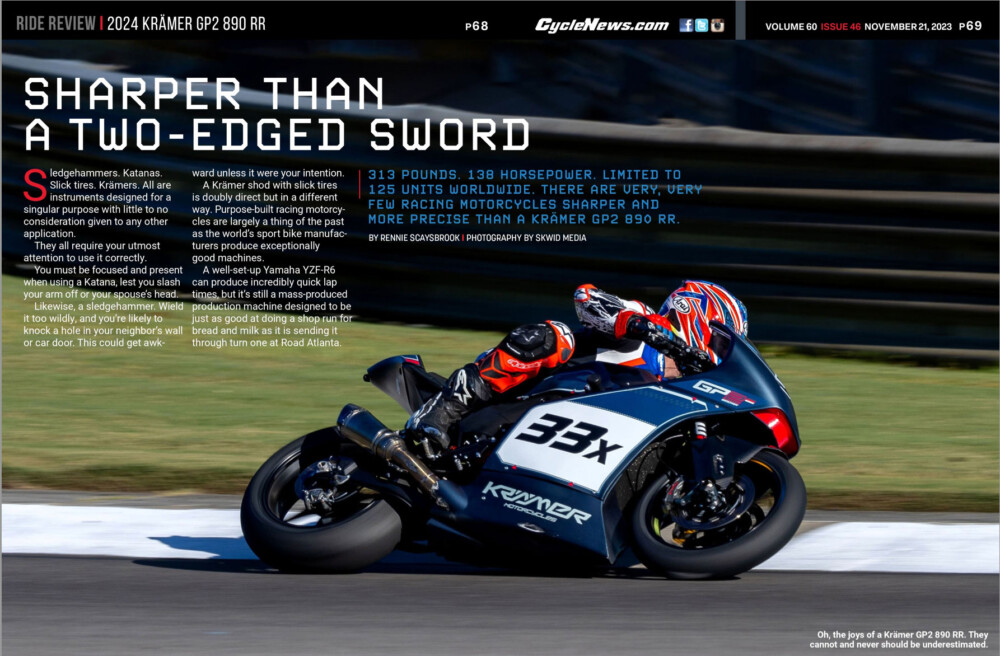Rennie Scaysbrook | November 23, 2023
Sledgehammers. Katanas. Slick tires. Krämers. All are instruments designed for a singular purpose with little to no consideration given to any other application.
They all require your utmost attention to use correctly.
You must be focused and present when using a Katana, lest you slash your arm off or your spouse’s head.
Likewise, a sledgehammer. Wield it too wildly, and you’re likely to knock a hole in your neighbor’s wall or car door. This could get awkward unless it were your intention.
A Krämer shod with slick tires is doubly direct but in a different way. Purpose-built racing motorcycles are largely a thing of the past as the world’s sportbike manufacturers produce exceptionally good machines.
 Oh, the joys of a Krämer GP2 890 RR. They cannot and never should be underestimated.
Oh, the joys of a Krämer GP2 890 RR. They cannot and never should be underestimated.
Photography by Skwid Media
A well-set-up Yamaha YZF-R6 can produce incredibly quick lap times, but it’s still a mass-produced production machine designed to be just as good at doing a shop run for bread and milk as it is sending it through turn one at Road Atlanta.
Limited to 125 units worldwide, the $39,995 Krämer GP2 890 RR is not a diluted, mass-produced tool. The Krämer GP2 890 RR is a motorcycle designed for one thing and one thing only—going fast around a racetrack.
I need to remind myself of the GP2 890 RR’s ability during the press launch race (yes, you read that correctly) at the recent Barber Vintage Festival, where the Krämer was allowed to compete against the big twins of Ducati, EBR and KTM.
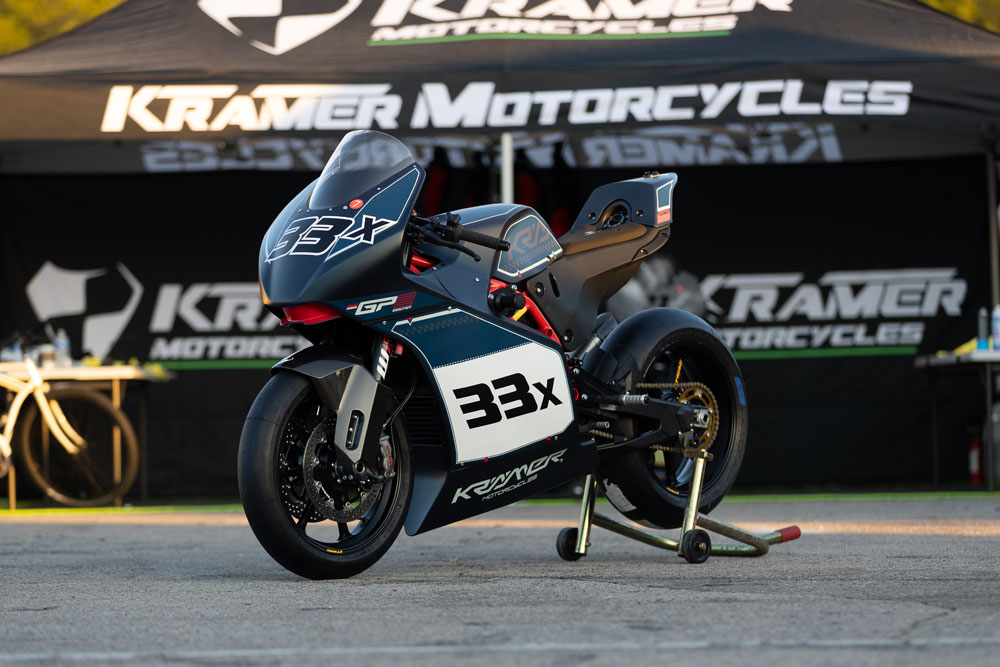 The big change in electronics is the addition of the Mectronik MKE7 ECU with a six-axis Inertial Measurement Unit.
The big change in electronics is the addition of the Mectronik MKE7 ECU with a six-axis Inertial Measurement Unit.
Charging down the short front straight, I brake as late as I dare, get ready to lean into the off-camber turn one, and get spooked as my teammate Chris Fillmore slides underneath me in the most perfect two-wheeled drift I’ve seen in many a year. This motorcycle can do this. And so much more. I wish I could download the footage from my brain and overlay Mozart’s Requiem in D Minor over it. Glorious.
The Krämer is so light, so nimble, and so razor sharp that it makes a production bike feel like a bit of a pig. A ready-to-race weight of 313 pounds will do that, especially when coupled with a heavily breathed-upon KTM 890 Duke motor pumping out a claimed 138 horsepower at the 190-section rear Pirelli slick tire.
This is far from my first foray with Krämer. I’ve ridden each of the company’s products before, having completed a five-hour endurance race on the single-cylinder HKR EVO2 R and a few races on the first GP2 890 R at the turn of the decade. Each time, I left impressed at the company’s persistence in making the best track machine this side of a Grand Prix paddock mere mortals could buy and disappointed I didn’t have the money to buy one.
The GP2 890 RR takes the lessons learned from competition in the admittedly odd-named GP2 category of the British Supersport Championship, where this machine is eligible to compete, and comments from owners across the globe. Let’s check out what’s been done.
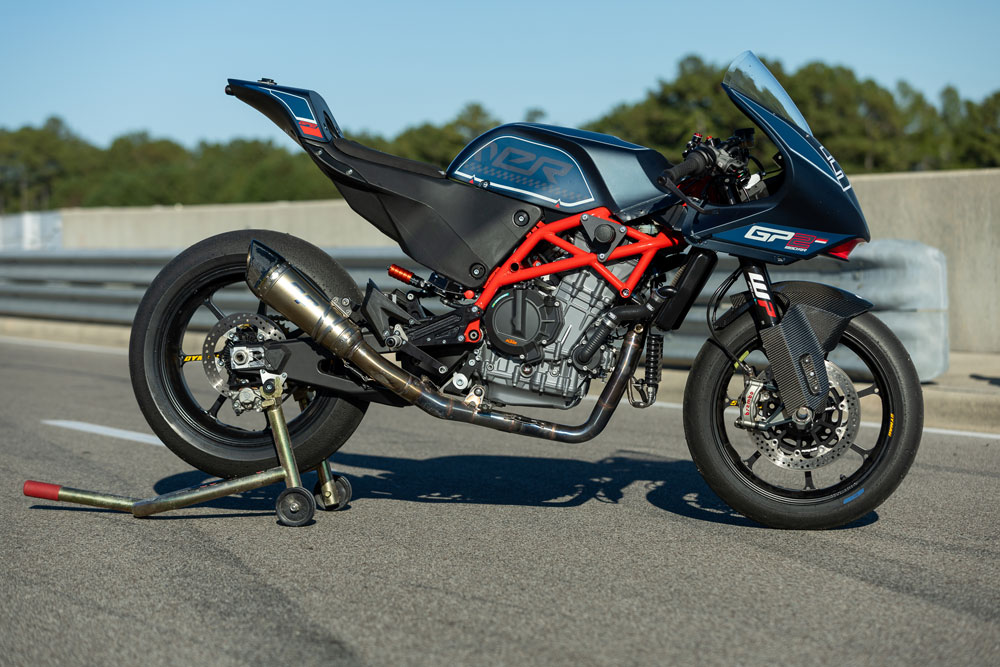 The heart of the RR, its engine, is much more adept at track torture than its predecessor.
The heart of the RR, its engine, is much more adept at track torture than its predecessor.
Electronics | 2024 Krämer GP2 890 RR Review
The big change comes with the addition of the Mectronik MKE7 ECU, equipped with a six-axis Inertial Measurement Unit. This has allowed for lean-angle sensitive, nine-level plus “off” traction and five-stage plus “off” wheelie control, launch control, and a pit lane speed limiter, as well as a much deeper dive into the various data points that allow finer setup changes.
“Everybody talks about wheelie and traction control, but what we wanted to focus on is the quality of the full experience of the bike,” says Krämer USA’s Joe Karvonen. “That was one of the biggest complaints we had on the previous gen of the 890. This is true to some other 890s is that the quickshifter function isn’t always the best. So, with this Mectronic ECU we’re allowed to do a lot broader parameter changes. It really, really helped to make it work better.”
 Turn speed on the Krämer is frankly ludicrous. It’s a case of waiting until you think you’re going to crash, slam it on its side, and you’ve probably still turned in too early. Proper race bike stuff.
Turn speed on the Krämer is frankly ludicrous. It’s a case of waiting until you think you’re going to crash, slam it on its side, and you’ve probably still turned in too early. Proper race bike stuff.
Engine | 2024 Krämer GP2 890 RR Review
The GP2 890 RR comes with titanium conrods, titanium inlet and exhaust valves, higher lift and longer duration camshafts on the intake and exhaust side, CNC ported cylinder-head, higher compression forged Pankl pistons, and larger Dell’Orto 48mm throttle bodies. Compression has been raised from 13.5:1 to 14.1:1. The crankshaft is the same as a base 890 Duke, as is the gearbox. However, you can opt for a Nova close ratio gearbox used in flat track and various sidecar racing outfits in Europe. Thankfully, the dreaded quickshifter that was on the 890 R that would kill the ignition if you breathed on it has been swapped out for a more robust race version.
“Yeah, much improved. We’re very excited about that part!” Karvonen says of the quickshifter. “It’s one of the biggest things we wanted to achieve with the different electronics package.”
 No wings on this bike, no sir. Fewer wings mean a higher top speed, which is the route Krämer has thankfully gone.
No wings on this bike, no sir. Fewer wings mean a higher top speed, which is the route Krämer has thankfully gone.
Main Chassis | 2024 Krämer GP2 890 RR Review
The chromoly steel-trellis chassis, powder coated in a rather fetching red, is one of the few things left untouched from the 890 R. “The one thing I think that gets overlooked is the GP2 chassis (R and RR-spec) does have adjustable rake, so it goes standard, zero, or you can do +/- half or +/- one degree of rake angle by changing the insert in the top of the frame,” Karvonen says. “It’s not a quick change but you can do it if you pull a triple clamp, swap the insert, and drop it back together. It has conical, self-centering, tapered steering hindrance.”
 As always, the fuel tank, seat and subframe triple as one unit. This gives many advantages, including better weight distribution and a more balanced chassis as the fuel load comes down over a race distance.
As always, the fuel tank, seat and subframe triple as one unit. This gives many advantages, including better weight distribution and a more balanced chassis as the fuel load comes down over a race distance.
Wheels | 2024 Krämer GP2 890 RR Review
Dymag has again been tasked with providing their beautiful UP7X 3.5-inch and six-inch front and rear forged aluminum wheels wrapped in 120/70-17 front and, for our test, a 180/60-17 rear slick. However, the 890 RR has been designed to run Pirelli’s World Supersport-spec 190/60-17 rear slick. “We did it mainly because after working with Pirelli and looking at the options, the 180-60 is really a 190-ish tire,” Karvonen says. “When you get into the 190s, it’s more like a 195, even on a 5.5-inch rim. So, on a six-inch rim, it can work on it just fine.”
Fork | 2024 Krämer GP2 890 RR Review
The fully adjustable WP Apex Pro 7543 closed-cartridge fork is outwardly the same but internally gets a new piston and revised damping. “On our older forks, the rebound leg also had some function of compression just inherently in its design,” says Karvonen. “So, we really increased the fork’s bypass capacity and allowed it to have a broader range of adjustability through the clickers, where our other forks were a little bit narrower in this regard.”
 Czech company RP makes the full titanium exhaust system. Like so much on the Krämer, it’s a beautifully machined piece.
Czech company RP makes the full titanium exhaust system. Like so much on the Krämer, it’s a beautifully machined piece.
Shock | 2024 Krämer GP2 890 RR Review
Like the fork, the WP Apex Pro 7746 shock utilizes different valving. The shock is fully adjustable for high and low-speed compression and rebound damping, uses a remote hydraulic preload adjuster, and you can change ride height via the adjustable suspension linkage mounting point Krämer calls flip shifts, just as on the 890 R.
New for the RR is the use of the progressive rear suspension link. “We did a lot with valving on the 890 R, whereas now we went to more of a linear valving and progressive link,” says Karvonen. “We always ran a linear rate spring, but we have more speed-sensitive main primary valving. So, it’s a little bit different logic.”
 Brembo RCS Corsasorta span- and ratio-adjustable master-cylinder offers excellent stopping power despite the calipers only gripping 290mm dics.
Brembo RCS Corsasorta span- and ratio-adjustable master-cylinder offers excellent stopping power despite the calipers only gripping 290mm dics.
Front Brake | 2024 Krämer GP2 890 RR Review
This remains unchanged in the radial-mount four-piston Brembo Stylema calipers, Moto Master 290mm discs and Brembo RCS 19 span- and ratio-adjustable master cylinder. “We are looking at an optional brake kit for 300mm discs if a rider is at a track that’s hard on braking or for someone who wants more braking capacity,” Karvonen says. “The focus on staying with 290mm discs is mainly to keep the weight down because the bike is lightweight. The rotational mass is so huge on the front end, and it’s very noticeable going from a 290 to a 300mm disc.”
The rear brake remains unchanged with a single 230mm full-floating disc with a Brembo P2 caliper.
Bodywork | 2024 Krämer GP2 890 RR Review
The top fairing on the 890 RR is significantly wider than the 890 R’s. Beautifully devoid of the dreaded winglet craze sweeping the world from MotoGP down, the RR’s wider top fairing adds a claimed nine percent more aerodynamic efficiency and a nine mph higher top speed. The fairing also puts added oomph into the RR’s ram-air effect. “The airbox itself with the new bodywork is completely different,” Karvonen says. “Not just the exterior, but the way the base of the airbox mounts and where the air filter fits to the throttle body is different. We’ve integrated the ram-air ducts more directly. It’s not a pressurized airbox, but it’s more of a force-fed airbox now. We tested it, but we didn’t find a lot of advantages to the pressurized airbox in this drive train. So, we’ve stuck with a fairly simple cold air feed.”
Fuel Tank | 2024 Krämer GP2 890 RR Review
One of the design trademarks of a Krämer is the subframe and seat unit doubling as the fuel tank module. At 4.2 gallons, its capacity to the 890 R remains unchanged, but larger 48mm throttle bodies meant a more powerful fuel pump was required, up from 3.5 to five bar.
“It’s quite a bit higher pressure than the previous fuel pump, and it also is larger,” Karvonen says. “The way it mounts to the tank is the same concept, but it’s completely different and not interchangeable with our old fuel tank fuel pump. We’ve kept the fuel injectors the same, but they’re now working at their maximum capacity.”
 You can see how much room there is to move on the Krämer chassis here.
You can see how much room there is to move on the Krämer chassis here.
Racer Testing | 2024 Krämer GP2 890 RR Review
I’ve gotten to do a lot of cool gigs in my time at this magazine, but I’ve never done a press launch that doubled as a race meeting.
Such was the case at the 2023 Barber Vintage Festival, where Joe and Brittany Karvonen, Krämer CEO Markus Krämer, and lead engineer Felix Richter handed me my own GP2 890 RR for four days.
Racing and testing are two historically different things because as soon as you see a guy in front of you, racing always, always takes precedence over testing, but it did give me a lot of track time to experience what the RR was capable of.
If you read my test from 2020 on the 890 R Krämer, you’ll know how impressed I was. A purpose-built race bike is always preferable to a production machine, and the 890 R was as sharp a tool as I’d ridden since I tested a Moto2 bike at Phillip Island in 2011. Fast forward to the 890 RR and things were ratcheted up somewhat.
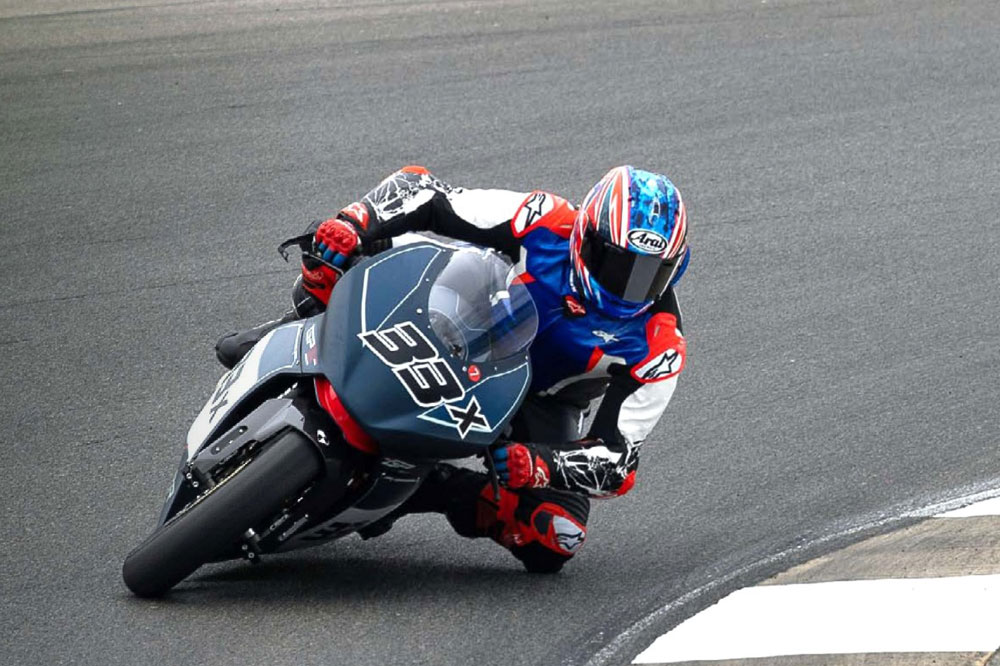 A little bit of front-end chatter was experienced over the course of the race weekend, but it’s something that can be tuned out with a bit of testing.
A little bit of front-end chatter was experienced over the course of the race weekend, but it’s something that can be tuned out with a bit of testing.
The most obvious of which is the engine. Far from being a slightly worked street bike motor, this RR’s heart is much more adept at track torture than its predecessor. There’s far more midrange torque, so much so that we kept lowering the gearing further and further to keep the motor in its beefy torque happy spot for the tight last sector of the Barber lap.
However, you can now wind the motor right out to the 10,500-rpm limiter, and it’ll make power almost all the way through the rev range, whereas the hard action limiter on the 890 R was something you desperately wanted to avoid running into. This makes for a more flexible motor, one you don’t have to be quite on your toes with, compared to the 890 R.
Likewise, the quickshifter. I didn’t get along with the hair-trigger quickshifter of the 890 R (like many a customer, it turns out), but the unit on the 890 RR is a far nicer, smoother setup. You’re still mated to the standard 890 Duke gearbox and need to be a bit careful of your shifts, but this is one of the big improvements of the bike.
As is the overall electronics package. The Mectronik MKE7 ECU, with its nine-stage traction control system, was light years ahead of the 890 R, which didn’t really have any TC to speak of. I was hindered a little in that the wheelie control algorithm wasn’t ready yet, so the electronics would cut the wheelie thinking it was the traction control, which meant I couldn’t carry a nice little floating wheelie to maximize acceleration. This will be fixed for the production machine, so don’t worry if you plan to throw down your hard-earned money.
As good as the new motor is, the shining star of the Krämer package is still that stunning chassis. I don’t know about you, but going around corners fast has always been more interesting to me than pinning it down a straight, and here, the Krämer has almost no competition.
We spent much of the Barber test/race playing with different spring weights and rear ride heights, trying to get the small amount of front-end-heavy chatter that could come in the last turn onto the front straight and again off the back straight, but that didn’t disguise the fact I was on the sharpest cornering tool on the track, including Geoff May’s WorldSBK EBR.
The revised WP Apex Pro 7543 closed cartridge fork has better support and feel than the unit found on the 890 R, especially at the top of the stroke when you first apply those excellent front brakes.
 Mission control for the Krämer GP2-890 RR is the five-inch AIM MXS1.3 dash with a built-in lap timer and pairs with the Mectronik MKE7 ECU that provides all data logging opportunities.
Mission control for the Krämer GP2-890 RR is the five-inch AIM MXS1.3 dash with a built-in lap timer and pairs with the Mectronik MKE7 ECU that provides all data logging opportunities.
Fast corners saw the Krämer track like it was on rails. Only when we had lots of force on the front end under braking and turning would I get a bit of chatter. This, of course, can be tuned out with a bit of testing, but as we didn’t have anything other than the standard 0.90 kg front springs in the kit, we were a bit limited in what we could do.
I upped the rear spring from the 0.84 kg unit to the 0.90 kg, and that made a big difference in helping keep the shock higher in the stroke under initial acceleration, thus ensuring the chassis wouldn’t run wide as the power was progressively fed in, allowing full use of those 138 horses hiding between the frame rails.
One of the great things about this Krämer and any Krämer is that they are designed with normal human heights in mind. These are not Moto3 race bikes designed for jockeys. They are roomy almost spacious for a racing motorcycle, which has several benefits, the least of which is reduced rider fatigue.
With the wider fairing, less wind pressure and spacy surround, combined with the incredible turn speed of the chassis, I could’ve ridden that bike all day and not gotten overly tired. This is a bike that does exactly what it says on the pack—it’s a purpose-built racing motorcycle, the closest thing you’ll likely ride to a Grand Prix bike—but one that is designed around riders of every skill level, whether you’re Chris Fillmore or a 70-year-old out for a track day spin. Yes, they command a healthy price, but your smile will be so big that you’ll feel like a road racing god on a GP2 890 RR.CN
VIDEO | 2024 Krämer GP2 890 RR Review
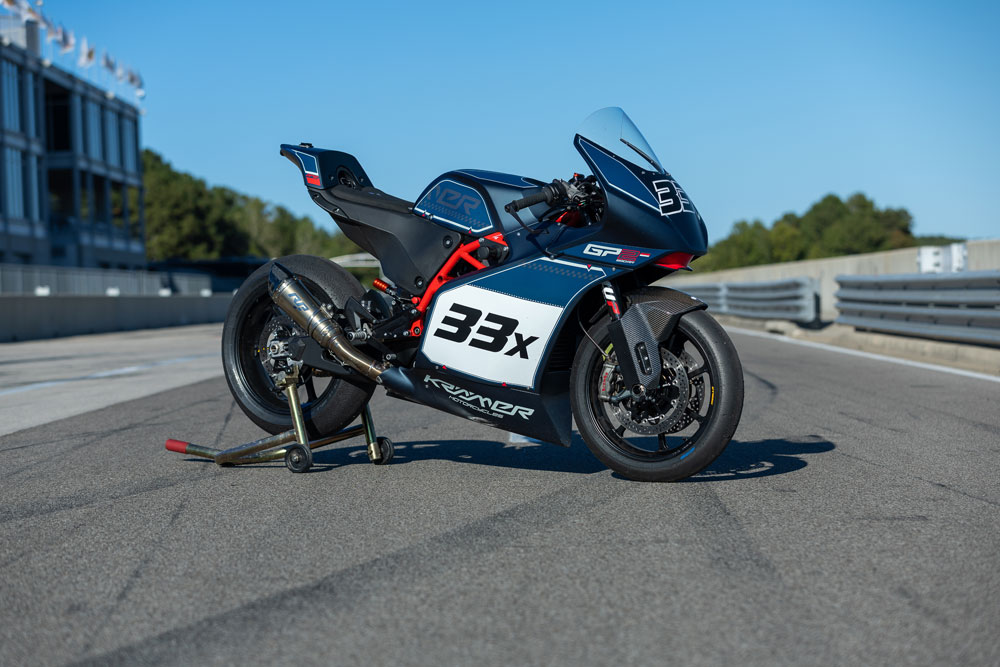
2024 Krämer GP2 890 RR Specifications
| MSRP: |
$39,995 |
| Engine: |
Inline 2-cylinder, |
| Valvetrain: |
DOHC, 8-valve |
| Cooling System: |
Liquid |
| Displacement: |
899cc |
| Bore x stroke: |
90.7 x 68.8mm |
| Fuel injection: |
Electronic fuel injection system, 48mm elliptical throttle bodies, Ride-by-Wire throttle |
| Compression ratio: |
14.1:1 |
| Exhaust: |
2-2-1 |
| Transmission: |
6-speed |
| Clutch: |
ASC slipper clutch, hydraulically actuated |
| Electronics: |
Adjustable Traction Control (9 Levels + Off), Adjustable Wheelie Control (5 Levels + Off), Pitlane Speed Limiter, five-inch AIM MXS1.3 dash |
| Chassis: |
Tubular steel trellis |
| Front suspension: |
WP Apex Pro 7543, closed-cartridge, fully adjustable, split function damping with Krämer shim stack |
| Rear suspension: |
WP Apex Pro 7746, fully adjustable, high- and low-speed compression, remote preload, ride-height adjustable with progressive linkage |
| Front brake: |
Dual 290mm full-floating discs, radially mounted Brembo Stylema monobloc four-piston calipers |
| Rear brake: |
230mm disc, Brembo twin-piston P2 caliper |
| Front tire: |
120/70-ZR 17 in. |
| Rear tire: |
180/60-17 in. |
| Seat height: |
NA/adjustable |
| Fuel capacity: |
4.2 gal. |
| Weight (curb, claimed): |
313 lbs. |
